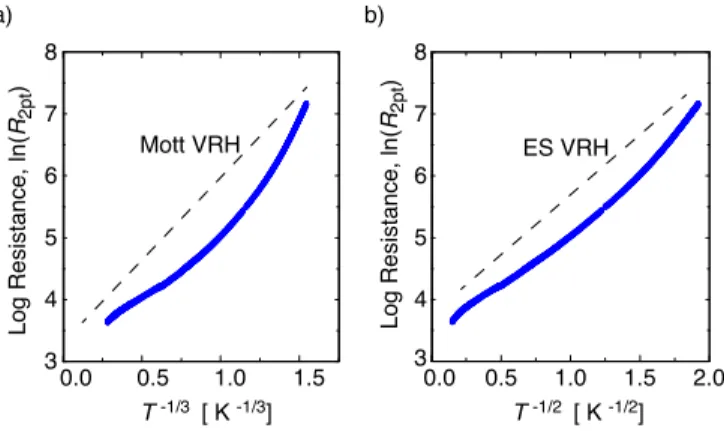Supplementary Information
J. Guillemette,1, 2 N. Hemsworth,3 A. Vlasov,3 J. Kirman,3 F. Mahvash,3, 4 P. L. L´evesque,5 M. Siaj,4 R. Martel,5 G. Gervais,1 S. Studenikin,6 A. Sachrajda,6 and T. Szkopek3, ∗
1Department of Physics, McGill University, Montr´eal, Qu´ebec, H3A 2A7, Canada 2
Department of Physics, John Abbott College, Montr´eal, Qu´ebec, Canada, H9X 3L9 3
Department of Electrical and Computer Engineering, McGill University, Montr´eal, Qu´ebec, H3A 2A7, Canada 4
Department of Chemistry, Universit´e du Qu´ebec `a Montr´eal, Montr´eal, Qu´ebec, H3C 3P8, Canada 5
Department of Chemistry, Universit´e de Montr´eal, Montr´eal, Qu´ebec, H3C 3J7, Canada 6National Research Council Canada, 1200 Montreal Road, Ottawa, Ontario, K1A 0R6
I. TEMPERATURE DEPENDENCE OF
RESISTANCE
The resistance versus temperature of the hydro-genated graphene samples in this study do not follow the Mott variable range hopping (VRH) law for a 2-dimensional conductor, nor does the resistance follow the Efros-Shklovskii variable range hopping (ES VRH) law. The former corresponds to a functional form R = R0exp[(T0/T )1/3] and the latter corresponds to a func-tional form R = R0exp[(T0/T )1/2]. We consider sample HGT2 here. A plot of ln(R) versus T−1/3 is shown in Fig. S1 a), and a plot of ln(R) versus T−1/2 is shown in Fig. S1 b). The measured resistance does not follow a linear relation in either plot, indicating that neither a Mott variable range hopping law nor an Efros-Shklovskii variable range hopping law describes the measured resis-tance. 0.0 0.5 1.0 1.5 T -1/3 [ K -1/3] 3 4 5 6 7 8 a) 3 4 5 6 7 8 0.0 0.5 1.0 1.5 2.0 T -1/2 [ K -1/2] Log Resistance, ln( R2pt ) Log Resistance, ln( R2pt ) b) Mott VRH ES VRH
FIG. S1: (a) A plot of ln(R) versus T−1/3 and (b) a plot of ln(R) versus T−1/2in zero magnetic field for sample HGT2.
